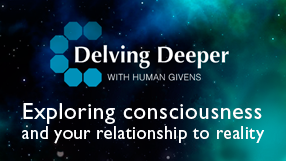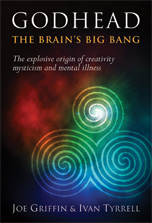This site was set up to gather quotations from mystics, poets and philosophers about the oscillating nature of reality
THE WONDER that scientists feel in the face of the behaviour of quantum particles can be difficult to appreciate if you haven’t devoted any time to these questions yourself. They found that the act of measuring them itself changes the behaviour of matter. Particles only behave like we would expect them to behave when observed. The observer collapses the wavefunction of particles simply by observing. When not observed, particles behave like waves of many possibilities.
The Nobel prize-winning physicist Richard Feynman described this as “the central mystery” of quantum theory, and then corrected himself, saying that, in fact, it is “the only mystery”. But these ponderings are at the heart of our investigation into consciousness and of our relationship with the Universe as explored in Godhead: the brain's big bang and we think it is well worth the effort it requires to think about them seriously.
The problem is that thinking about these ideas alone is not enough. One also has to have a direct perceptual relationship with them. This was recognized by the American physicist Robert Oppenheimer when he said: “These two ways of thinking, the way of time and history, and the way of eternity and timelessness, are both parts of man’s effort to comprehend the world in which he lives. Neither is comprehended in the other nor reducible to it … each supplementing the other, neither telling the whole story.”
A person today who declares, “God created the world” is rightly regarded as not really answering the question. The statement is clearly a copout, for the obvious reason that saying something out there created everything doesn’t answer the supplementary question, “What created that something?” Even the most fundamentalist believer must have an uneasy feeling when faced with the intelligent child’s query in response to being told that God created the world, “Who created God, then?”
On the other hand, a reductionist physicist, ignoring the child’s quite legitimate query, might just say, “The question is irrelevant because there was nothing there to begin with. This whole ordered Universe, matter, life, consciousness, appeared out of nothing.” This seems to us just as much of a cheat: one type of fundamentalist is saying “God created the Universe”, and another that “out of nothing the Universe created itself!” Both positions are meaningless if you can’t explain how the Universe emerged from nothing.
To give up at this point is also a copout. Our brains have evolved to be able to reflect on the nature of reality and our relationship with it, and our logical thought processes are entwined in this process, so we should trust in our ability to think things through. Logically, this means that if we can ask ourselves, “What created the Universe?” we can’t answer with a non-answer and say either, “God did,” or, “It came from nowhere”; we must look for an answer that rings true to the highest reach of our intelligence.
A curious but revealing fact is that people in the distant past (from the perspective of relative time) directly perceived the oscillating nature of the Universe: they knew the secret of the quantum. We know this because of the many similar attempts to describe it in ancient spiritual teachings found all over the world, although, of course, they didn’t use the language of quantum physics. This means that what is currently regarded as the frontier of physical science was crossed long ago by remarkable individuals. But where scientists might talk of an oscillation between, say, magnetism and electricity, mystics would express the idea in more poetical ways: “As above, so below,” from the Hermetic tradition (Hermes), or, “That comes out of this, and this depends upon that” (Chuang-tzu) and “Being and Notbeing grow out of one another” (Tao Te Ching), from the Taoist wisdom schools.
Going into more detail about how humans experience this universal occurrence with the authority of direct experience, the Andalusian Sufi, Ibn al-Arabi, born in 1165, wrote succinctly about what physicists like Wheeler, Barbour and Hawking attempt to describe in the 21st century:
"There is no temporal interval between the annihilation and the re-manifestation, so that one does not perceive an interruption between the two analogous and successive creations, and this existence appears homogenous… In so far as man is a possibility of manifestation but he does not see that which manifests him, he is pure absence; contrarily, in so far as he received his being from the perpetual irradiation of the Essence, he is. The incessant revelation of the Divine Activities flowing from the Divine Names renews him after each annihilation, instantaneously, without perceptible temporal succession, but following a purely logical succession, for there is but one permanent non-existence, which is that of pure possibility, and there is one permanent Being, the revelation of the Essence being one, and then the activities and the individuations succeeding each other with the breaths which flow from the Divine Names, since the individuals renew themselves at each present instant …"
The Christian mystic Meister Eckhart, born in Germany about 100 years after Ibn al-Arabi, expressed the same knowledge:
“There exists only the present instant ... a NOW which always and without end is itself new. There is no yesterday nor any tomorrow, but only NOW, as it was a thousand years ago and as it will be a thousand years hence … the Eye with which I see God is the same Eye with which God sees me.”

